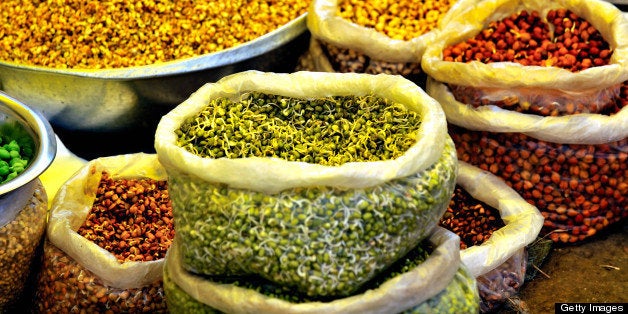
India has long harbored a tradition of ethical vegetarianism, anchored on the dharmic traditions' commitment to ahimsa (nonviolence). This tradition can perhaps be encapsulated by Prabhupada's statement, "Indulgence in animal killing for the taste of the tongue is the grossest kind of ignorance," in his translation of Bhagavad Gita 14.16. In particular, for its importance in agriculture and providing milk, the cow has been accorded a special sacred respect in this tradition. Yet, just last year, India attained the dubious distinction of being the largest beef exporter in the world.
In 2009, the UPA government in New Delhi established the Ministry of Food Processing Industries (MFPI), which announced the advent of a "Pink Revolution," noting that India accounted for only 2 percent of the global meat market despite vast potential. Since that time, India's beef production has already doubled and its share in the beef industry has increased from 8 percent to 25 percent. Such a policy has deleterious implications for a nation with as many faith-based communities and as precarious an ecological situation as India.
The most common argument in favor of the policy is that the government is simply responding to increased demand for meat within a middle class that has undergone a dramatic change in dietary patterns. In 2006, for the first time, the percentage of vegetarians in India slipped to 40 percent. Naturally, demand for meat and dairy products has skyrocketed. Why fault a government for supplying demand? The answer lies in one of the contexts of these dietary shifts. One of the main sources of protein for vegetarian Indians has traditionally been daal, a mixture of lentils. However, due to drought combined with a failure to incentivize cultivation of legumes, India hiked importation of pulses, worsening an already cascading problem of food inflation. One report noted, "Once called the poor man's diet, daal is now unaffordable." In contrast, MFPI has provided generous tax breaks to the beef industry, making it the cheapest source of protein, according to Asia Times. Under increasing pressures to make ends meet, and bearing the brunt of the inflation under the current regime, much of the middle class has replaced daal with beef.
It has also been proposed that the Pink Revolution would provide Muslim and Christian communities greater access to food upon which their religions place no dietary restrictions. Notwithstanding the merits this argument seems to have, India produces more beef than the United States, a country with a self-sufficient beef market with six times the demand of beef as India. Hence, the question of meeting domestic demand through this increase never arises. Conversely, and rather unfortunately, the plan is sure to disturb an interfaith tinderbox since many staunchly vegetarian Hindus perceive Muslims to be responsible for running many of the country's slaughterhouses.
On the other hand, the government of India has missed out on a significant opportunity to emphasize its notion of "food security" through means that find emphasis in all of the major religions on the subcontinent. The solution is going green, not pink. Sanatana Dharma's emphasis on caring for the environment is extensive, and is a component of my religious tradition that I hold onto dearly. As one Vedic prayer puts it, "Do not harm the environment; do not harm the water and the flora ... Tranquillity be to the atmosphere, to the earth, to the waters, to the crops and vegetation." In the Abrahamic faiths, there is also emphasis on keeping guardianship over and protecting God's creation, while His Holiness the Dalai Lama has noted that in the modern age, there is a growing sense of Universal Responsibility that extends beyond human-human contact to how we interact with other forms of life and the environment.
Despite important differences, this abstract, shared concept of ecological stewardship has great promise for tying communities together rather than ripping them apart, as the Pink Revolution appears to be doing. While academic programs such as the Forum for Religion and Ecology at Yale have flourished, such a connection has yielded modest concerted attempts at the ground level where it matters most. However, as prominent ecology scholar B.A. Byers has noted through quantitative study, environmental protection is strengthened by local religious and spiritual traditions. We see this principle put into practice, for example, in efforts such as the recent restoration of the Onehunga Bay wetlands in New Zealand by an interfaith coalition. India's case is particular promising because as local authorities like D.N. Pandey have noted, these local spiritual traditions of ecology have long existed. Given the importance of faith and tradition to India's 60 percent rural population, their desperately needed revival poses a wealth of opportunity for interaction across ethno-religious boundaries.
But what exactly is the way forward? And how are going green and pink intrinsically opposed? Of course, much of Hindu thought suggests killing for meat weighs one down with karmic bondage, while caring for the environment promotes a spiritual kinship with nature. In a nation burdened by mercurial monsoons and lacking in irrigation infrastructure (55 percent of crops are watered by rain), investing 15.5 kL of water in each pound of beef produced only exacerbates the situation. Little attention has been paid to schemes such as the solar canal initiative in the state of Gujarat, which aims to provide irrigation and limit the evaporation of water all while producing renewable energy.
Vandana Shiva, India's foremost environmental activist who is inspired by her Hindu roots, notes that the future of Indian agriculture lies in small, sustainable farms, not large agribusiness. To this end, slashing tractor subsidies which can provide only environmental damage and encouraging the re-introduction of oxen and cows onto small farms will go a long way to reducing the environmental impact of the country's farming practices. In fact, this was the norm until very recently, with the NDA government's National Commission on Cattle making virtually the same proposal in 2001 (which was sadly never acted upon). Other small changes, like promoting the cultivation of pulses, will not only improve soil quality to increase yields, but also provide a traditional, nutritional source of protein.
Thus, the Pink Revolution is at odds with promoting a sustainable future for India. There are not only moral and religious but also several environmental drawbacks from the government's policies (not all of which could possibly be recounted in one blog post), and they merit serious re-thinking. At a time when vegetarianism is on the rise in the West, the Pink Revolution is seriously failing on both an interfaith and environmental level, thereby threatening to bring down with it an ethical tradition that has lasted for millennia.
